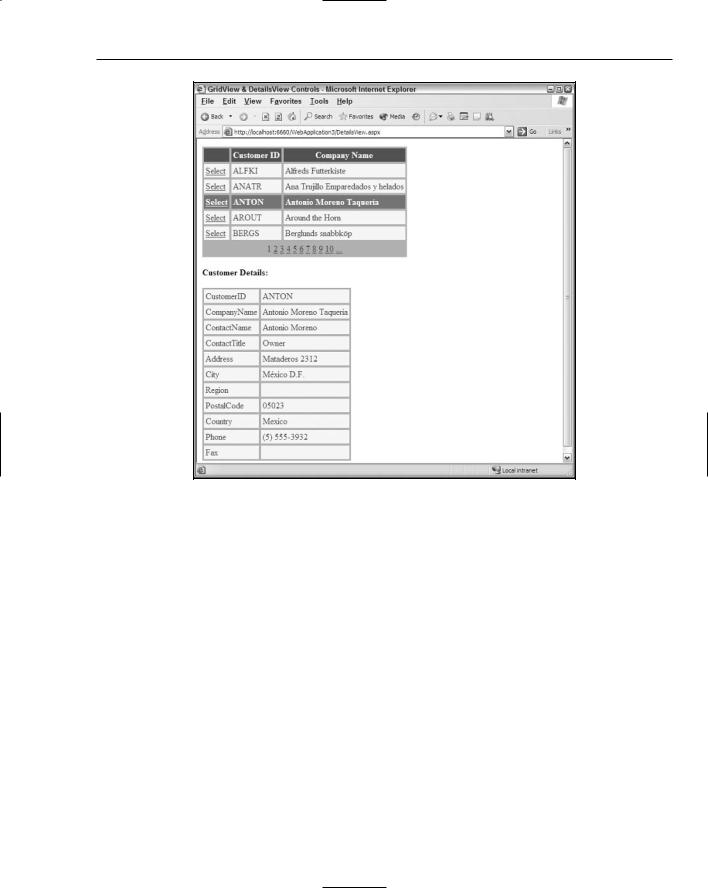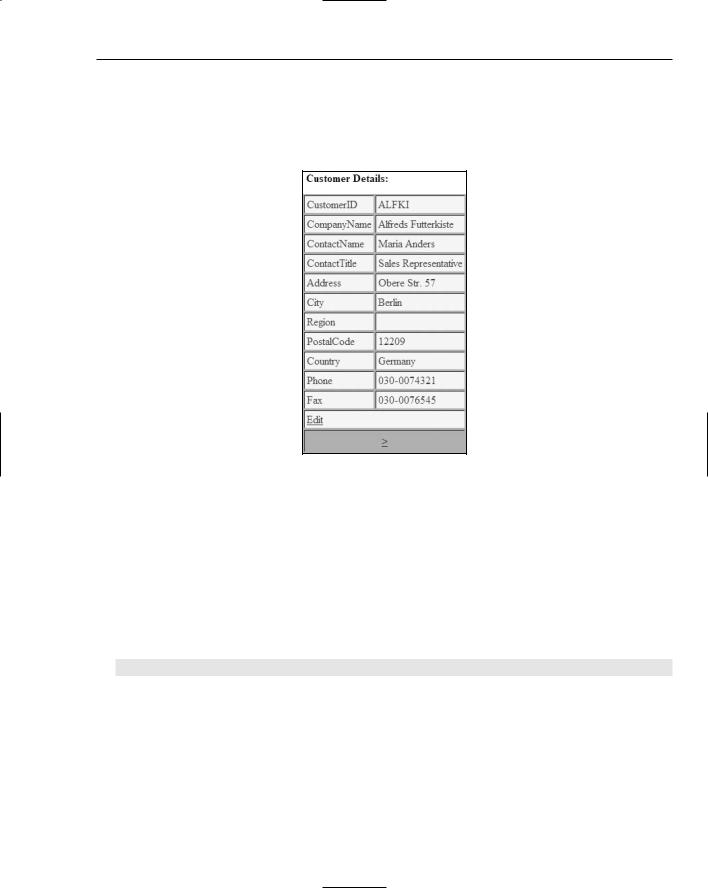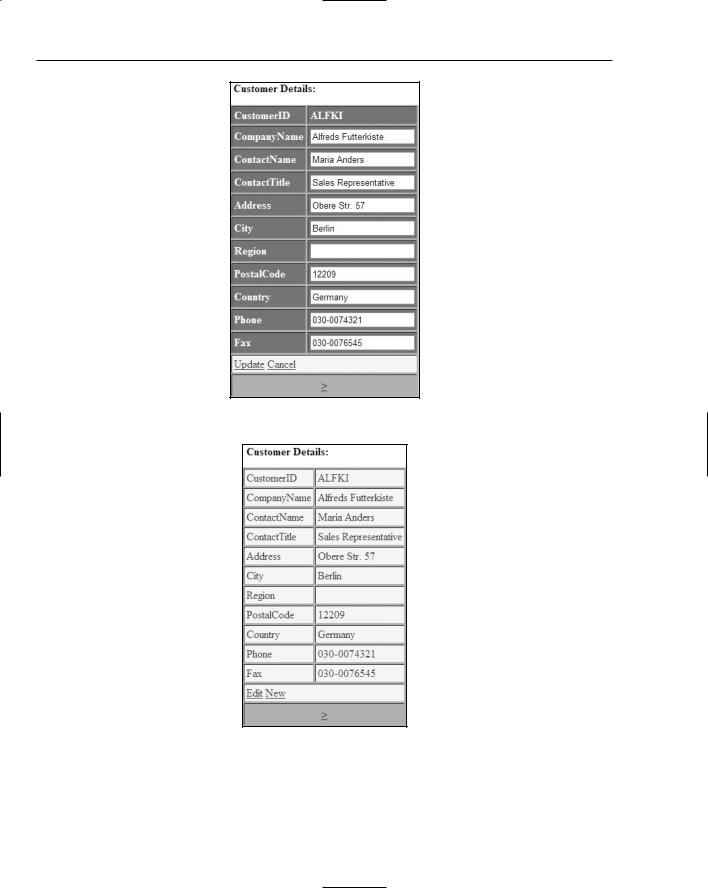
- •Contents
- •Introduction
- •Acknowledgments
- •The Goals of ASP.NET 2.0
- •Developer productivity
- •Administration and management
- •Performance and scalability
- •Device-specific code generation
- •Additional New Features of ASP.NET 2.0
- •New developer infrastructures
- •New compilation system
- •Additions to the page framework
- •New objects for accessing data
- •New server controls
- •A New IDE for Building ASP.NET 2.0 Pages
- •The Document Window
- •Views in the Document Window
- •The tag navigator
- •Page tabs
- •Code change status notifications
- •Error notifications and assistance
- •The Toolbox
- •The Solution Explorer
- •Lost Windows
- •Other Common Visual Studio Activities
- •Creating new projects
- •Making references to other objects
- •Using smart tags
- •Saving and importing Visual Studio settings
- •Application Location Options
- •Built-in Web server
- •Web site requiring FrontPage Extensions
- •The ASP.NET Page Structure Options
- •Inline coding
- •New code-behind model
- •New Page Directives
- •New attributes
- •New directives
- •New Page Events
- •Cross-Page Posting
- •New Application Folders
- •\Code folder
- •\Themes folder
- •\Resources folder
- •Compilation
- •The New Data Source Controls
- •The SqlDataSource and GridView Controls
- •Reading data
- •Applying paging in the GridView
- •Sorting rows in the GridView control
- •Defining bound columns in the GridView control
- •Enabling the editing of rows in the GridView control
- •Deleting data from the GridView
- •Dealing with other column types in the GridView
- •Selecting which fields to display in the DetailsView control
- •Using the GridView and DetailsView together
- •Updating, inserting, and deleting rows
- •XmlDataSource Control
- •ObjectDataSource Control
- •SiteMapDataSource Control
- •DataSetDataSource Control
- •Visual Studio 2005
- •Connection Strings
- •Site Maps
- •The PathSeparator property
- •The PathDirection property
- •The ParentLevelsDisplayed property
- •The ShowToolTips property
- •Examining the parts of the TreeView control
- •Binding the TreeView control to an XML file
- •Selecting multiple options in a TreeView
- •Specifying custom icons in the TreeView control
- •Specifying lines used to connect nodes
- •Working with the TreeView control programmatically
- •Applying different styles to the Menu control
- •Menu Events
- •Binding the Menu control to an XML file
- •SiteMap Data Provider
- •SiteMapViewType
- •StartingNodeType
- •SiteMap API
- •Why Do You Need Master Pages?
- •The Basics of Master Pages
- •Coding a Master Page
- •Coding a Content Page
- •Mixing page types and languages
- •Specifying which master page to use
- •Working with the page title
- •Working with controls and properties from the master page
- •Nesting Master Pages
- •Container-Specific Master Pages
- •Event Ordering
- •Caching with Master Pages
- •Using ASP.NET 2.0 Packaged Themes
- •Applying a theme to a single ASP.NET page
- •Applying a theme to an entire application
- •Applying a theme to all applications on a server
- •Removing themes from server controls
- •Removing themes from Web pages
- •Removing themes from applications
- •Creating Your Own Themes
- •Creating the proper folder structure
- •Creating a skin
- •Including CSS files in your themes
- •Having your themes include images
- •Defining Multiple Skin Options
- •Programmatically Working with Themes
- •Themes and Custom Controls
- •Authentication
- •Authorization
- •ASP.NET 2.0 Authentication
- •Setting up your Web site for membership
- •Adding users
- •Asking for credentials
- •Working with authenticated users
- •Showing the number of users online
- •Dealing with passwords
- •ASP.NET 2.0 Authorization
- •Using the LoginView server control
- •Setting up your Web site for role management
- •Adding and retrieving application roles
- •Deleting roles
- •Adding users to roles
- •Getting all the users of a particular role
- •Getting all the roles of a particular user
- •Removing users from roles
- •Checking users in roles
- •Using the Web Site Administration Tool
- •The Personalization Model
- •Adding a simple personalization property
- •Using personalization properties
- •Adding a group of personalization properties
- •Using grouped personalization properties
- •Defining types for personalization properties
- •Using custom types
- •Providing default values
- •Making personalization properties read-only
- •Anonymous Personalization
- •Enabling anonymous identification of the end user
- •Working with anonymous identification events
- •Anonymous options for personalization properties
- •Migrating Anonymous Users
- •Personalization Providers
- •Working with the Access personalization provider
- •Working with the SQL Server personalization provider
- •Using multiple providers
- •Building Dynamic and Modular Web Sites
- •Introducing the WebPartManager control
- •Working with zone layouts
- •Understanding the WebPartZone control
- •Explaining the WebPartPageMenu control
- •Modifying zones
- •Caching in ASP.NET 1.0/1.1
- •Output caching
- •Partial page caching
- •Data caching using the Cache object
- •Cache dependencies
- •ASP.NET 2.0 unseals the CacheDependency class
- •Enabling databases for SQL Server cache invalidation
- •Enabling tables for SQL Server cache invalidation
- •Looking at SQL Server
- •Looking at the tables that are enabled
- •Disabling a table for SQL Server cache invalidation
- •Disabling a database for SQL Server cache invalidation
- •Configuring your ASP.NET Application
- •Adding more than one table to a page
- •Attaching SQL Server cache dependencies to the Request object
- •Attaching SQL Server cache dependencies to the Cache object
- •Customizing the side navigation
- •Examining the AllowReturn attribute
- •Working with the StepType attribute
- •Adding a header to the Wizard control
- •Utilizing Wizard control events
- •Working with images from disk
- •Resizing images
- •Displaying images from streams
- •The MMC ASP.NET Snap-In
- •General
- •Custom Errors
- •Authorization
- •Authentication
- •Application
- •State Management
- •Advanced
- •ASP.NET Web Site Administration Tool
- •Home
- •Security
- •Profile
- •Application
- •Provider
- •Managing the Site Counter System
- •Generics
- •Iterators
- •Anonymous Methods
- •Operator Overloading
- •Visual Basic XML Documentation
- •New Visual Basic Keywords
- •Continue
- •Using
- •Global
- •Index

New Ways to Handle Data
Figure 4-22
Using the <FilterParameters> element within the AccessDataSource control is the same as using it with the SqlDataSource control. In this case, the AccessDataSource control in Listing 4-18 uses an <asp:ControlParameter> to specify the name of the parameter, the control that the parameter value is coming from (the GridView1 control), and the property name from the control that is used to populate the parameters value.
In the GridView1 control, be sure to include the DataKeyNames attribute. This control gives this attribute a value of CustomerID — meaning that when the end user selects one of the rows in the table, the CustomerID value for that chosen row becomes what is provided via the SelectedValue property.
Updating, inserting, and deleting rows
Updating rows in the DetailsView control is quite similar to updating rows in the GridView — but with a few little twists that you should be aware of. The process for inserting and deleting rows is very similar to that for updating rows (shown here). First, to update data being displayed by the DetailsView control, you modify the <asp:AccessDataSource> control so that it allows for the editing of the data to which it is connected. The main node of the <asp:AccessDataSource> element is shown in Listing 4-19.
105

Chapter 4
Listing 4-19: The <asp:AccessDataSource> element
<asp:AccessDataSource ID=”AccessDataSource1” Runat=”server” SelectCommand=”Select * From Customers”
UpdateCommand=”UPDATE [Customers] SET [CompanyName] = ?, [ContactName] = ?, [ContactTitle] = ?, [Address] = ?, [City] = ?, [Region] = ?, [PostalCode] = ?,
[Country] = ?, [Phone] = ?, [Fax] = ? WHERE [CustomerID] = ?” DataFile=”Data/Northwind.mdb” FilterExpression=”CustomerID=’@CustID’”>
...
</asp:AccessDataSource>
A few things have been added to the AccessDataSource control to enable it to edit the data from the Northwind.mdb file. The first addition is that the UpdateCommand attribute has been added with a SQL command that updates the data store based upon a large collection of parameters that I define shortly.
The next required change to the AccessDataSource control is the addition of the update parameter definitions. You do this by using the <UpdateParameters> element within the AccessDataSource control itself. This is illustrated in Listing 4-20.
Listing 4-20: Adding the Update parameters to the AccessDataSource control
<UpdateParameters>
<asp:Parameter Type=”String” Name=”CompanyName”></asp:Parameter> <asp:Parameter Type=”String” Name=”ContactName”></asp:Parameter> <asp:Parameter Type=”String” Name=”ContactTitle”></asp:Parameter> <asp:Parameter Type=”String” Name=”Address”></asp:Parameter> <asp:Parameter Type=”String” Name=”City”></asp:Parameter> <asp:Parameter Type=”String” Name=”Region”></asp:Parameter> <asp:Parameter Type=”String” Name=”PostalCode”></asp:Parameter> <asp:Parameter Type=”String” Name=”Country”></asp:Parameter> <asp:Parameter Type=”String” Name=”Phone”></asp:Parameter> <asp:Parameter Type=”String” Name=”Fax”></asp:Parameter> <asp:Parameter Type=”String Name=”CustomerID”></asp:Parameter>
</UpdateParameters>
Each of these parameters defines what is used in the UpdateCommand string. Now that the AccessDataSource control is ready, turn your attention to the DetailsView control.
You need to make only a few changes to the DetailsView control. First, you add the Edit button to the control just as you added it to the GridView control. This is illustrated in Listing 4-21.
Listing 4-21: Adding an Edit button to the DetailsView control
<asp:DetailsView ID=”DetailsView1” Runat=”server” DataSourceId=”AccessDataSource1” DataKeyNames=”CustomerID” AllowPaging=”True” BorderColor=”#DEBA84” BorderStyle=”None” BorderWidth=”1px” PagerSettings-Mode=”NextPrevious” BackColor=”#DEBA84” CellSpacing=”2” CellPadding=”3” AutoGenerateRows=”True” AutoGenerateEditButton=”True”>
...
</asp:DetailsView>
106

New Ways to Handle Data
You add an Edit button to the DetailsView control via the use of the AutoGenereateEditButton attribute, which you set to True. You should also add a DataKeyNames attribute, which points to the IDENTITY field that should be utilized for the update. In this case, it is the CustomerID field. After this is in place and running, the DetailsView control appears with an Edit link at the bottom of the control (as shown in Figure 4-23).
Figure 4-23
If the end user clicks on the Edit hyperlink, most of the fields within the DetailsView control are changed to allow for editing, and the Edit hyperlink is replaced with an Update and Cancel hyperlink, as shown in Figure 4-24.
Adding the capability to insert or delete rows using the AccessDataSource control is the same as using the SqlDataSource control as shown earlier in the chapter.
The DetailsView control also works like GridView control in regard to inserting and deleting data. To insert additional rows into the Access file using the DetailsView control, simply add the AutoGenerateInsert attribute to the control:
AutoGenerateInsertButton=”True”
After this is in place, you find a New hyperlink next to the Edit hyperlink, as illustrated in Figure 4-25.
107

Chapter 4
Figure 4-24
Figure 4-25
108
